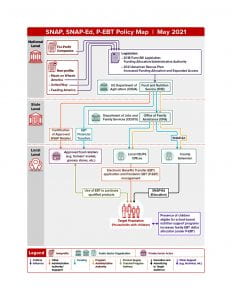COVID-19 highlighted notable systemic weaknesses across the food system in Ohio and the U.S. at large. Given the disruptions in the food system as part of their response to the pandemic in 2020, our OSU research team forged new partnerships with the Ohio Emergency Management Agency (Ohio EMA) Emergency Support Function (ESF) 6 (Mass Care) and ESF 11 (Food and Agriculture), and initiated a field mapping process to visualize and understand how Ohio state government agencies, civil society, nonprofits and the private sector intersect with the food system to respond to disasters in Ohio.
Analyzing interviews with state agencies and secondary data the team was able to map how food system-related policies interact with state-level agencies and organizations and visualize the administrative, political, and financial relationships between the initiating agency/organization of food policy and the target population of that policy The overall goal of the project was to understand the system in which Ohio EMA is embedded in order to better plan and prepare for future emergencies, disasters and disruptions.
Research Products and Findings
Final Report
The final research report: 1) contextualizes the impact COVID-19 had on Ohio’s food system; 2) examines the role of Ohio state government agencies and nonprofits involved with food system-related programs and policies, and; 3) maps how food-related policies and programs interact with these state-level agencies and organizations and visualize their relationships. The report includes research methods and key takeaways for short, medium and long-term food system resilience planning in Ohio.
- Download the Final Report: “Preparing For Food System Resiliency in Ohio: Policy and Planning Lessons from COVID-19”
- Download the Executive Summary: “Executive Summary. Preparing for Food System Resiliency in Ohio: Policy and Planning Lessons from COVID-19”
Policy Database
The research team compiled a database of food and agriculture policies and programs in Ohio with information on which state-level organizations and institutions are responsible for administering each.
- Download the Database: 2021 Ohio Food Policies (Excel)

Policy Field Maps
The research team developed a series of policy field maps that visually depict the administrative and financial relationships involved in implementing food and agriculture policies and programs.
Sample map of the Supplemental Nutrition Assistance Program (SNAP) and related programs (right).
The Fog of Response Map
Many policies and programs that support food security and nutrition are administered by different agencies and organizations with little or no connection to each other. When all policies and programs are mapped in the same image the extreme complexity of the food policy landscape within state-level agencies and organizations in Ohio becomes visible. 
Parallel to the ‘fog of war’ where soldiers find themselves fighting in dense fog or darkness and do not know if they are firing on friend or foe, leading to unintended and sometimes tragic consequence, the complexity of this policy landscape can lead to a “fog of response” for state agencies and organizations connected directly and indirectly to the food system.
Key Research Takeaways
- Emergency preparedness plans approach disasters as relatively isolated, short term problems and were note prepared for a disaster that disrupted supply chains at every level from production to consumption.
- Administrative capacity and lack of coordination hindered short-term policy responses to the pandemic. Siloed programmatic responsibility across state and federal agencies coupled with with the constantly changing food policy matrix at the federal state and local level complicated the ability of state agencies to coordinate services.
- Ohio state agencies historically not considered central to food systems became pivital. For example, transportation agencies impacted the shipping of food and social service agencies had to deal with the increases in domestic violence which can be triggered by disagreements over food.
Opportunities & Next Steps
- Invest in a diversified food system. Shorter supply chains (e.g. direct to consumers) were better positioned to adapt to changing market conditions compared to producers selling into commodity markets. Greater support for small, medium and large farms selling through a variety of markets will build supply chain resiliency during emergencies, disasters and disruptions.
- Develop coordinated emergency preparedness plans that account for and integrate food systems. The impacts of the pandemic on Ohio’s food system emphasize the importance of integrating the broader food system and the interactions between various organizations and agencies in order to foster a food system resilient to disasters and disruptions.
- Develop greater inter-agency and inter-organizational connectivity and communication. Preparing for the next crisis will require fostering connectivity and coordination across state-level agencies and organizations. At the state level, there is a need to facilitate stronger relationships, coordination, and awareness among key agencies and organizations, including those indirectly associated with food and agriculture.
To learn more about the research process, findings, key takeaways, and recommended next steps, read the full project report. “Preparing For Food System Resiliency in Ohio: Policy and Planning Lessons from COVID-19”
Project Presentations and Journal Articles
“Preparing the Food System for the Next Disaster” – Dr. Shoshanah Inwood presents a 5-minute summary of the project and key findings for the NSF Food Security in Extreme Environments and Food Deserts virtual convening.
Project Team Members
Shoshanah Inwood, School of Environment and Natural Resources, OSU
Zoë Plakias, Department of Agricultural, Environmental and Development Economics, OSU
Jill Clark, John Glenn College of Public Affairs, OSU
Nicole Wright, Ohio Sea Grant, School of Environment and Natural Resources, OSU
Aiden Irish, John Glenn College of Public Affairs, OSU
Josh D. Vittie, Ohio Emergency Management Agency, Ohio Department of Public Safety
This work is supported by a grant from The Ohio State University’s Initiative for Food and AgriCultural Transformation (InFACT), a Discovery Themes program.
